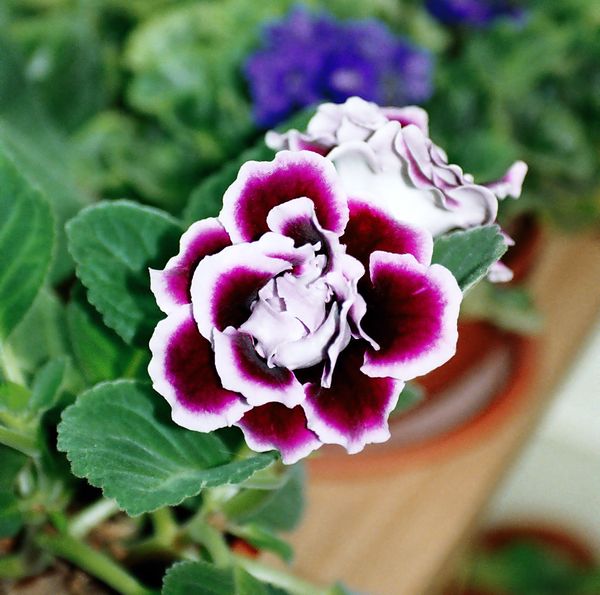Gloxinia Care Guide
How to grow and care for Gloxinia (Sinningia speciosa)
Welcome to the world of Gloxinia, scientifically known as Sinningia speciosa. These spectacular indoor plants are famed for their velvety, trumpet-shaped flowers and lush foliage. Originating from Brazil, Gloxinias bring a tropical touch to your home, boasting blooms in vibrant hues of purples, reds, and pinks. With the right care, these plants can flourish indoors, adding beauty and color to your living space.

Disclosure: This content includes affiliate links, which means we may earn a commission if you click on a link and make a purchase. As an Amazon Associate, we earn from qualifying purchases. This comes at no extra cost to you and helps offset the cost of running Leafwise. Please read our disclaimer for more info.
Table of Contents
Care
Light
Gloxinia plants thrive in bright, indirect sunlight. Direct sun can scorch their delicate leaves, so place them near a window filtered with sheer curtains or in a location that receives bright daylight without direct exposure. For optimal flowering, provide 12–14 hours of bright, indirect light daily. During the winter or in low-light spaces, consider supplementing with fluorescent or LED grow lights.
Temperature
The ideal temperature range is between 65°F and 75°F (18°C to 24°C). Maintain a stable environment and avoid exposing the plant to temperatures below 60°F (15°C). Avoid placing them near drafts or in areas with sudden temperature changes.
Humidity
Gloxinia enjoys moderate to high humidity. Aim for 50–60% humidity. Increase humidity by placing the pot on a tray of moist pebbles or using a humidifier. Avoid misting the leaves directly, as water droplets can cause spotting or mildew.
Watering
Water thoroughly when the top inch of the soil feels dry, typically once or twice a week depending on temperature and humidity. Avoid overwatering, as it can lead to root rot. Always use room-temperature, filtered or distilled water, and water from the bottom or direct water at the soil level to prevent splashing on the leaves.
Soil
Use a light, well-draining potting mix with good aeration. A mix formulated for African violets—typically containing peat moss, perlite, and vermiculite—works well to maintain proper moisture balance without becoming soggy.
Maintenance
Fertilization
During the growing season, feed every two weeks with a balanced, water-soluble liquid fertilizer at half strength. Always follow the fertilizer label instructions to avoid overfeeding, which can damage roots and inhibit blooming., which can damage roots and inhibit blooming. Do not fertilize during dormancy.
Grooming
Remove spent blooms and yellowing leaves regularly to encourage continued flowering and reduce the risk of fungal issues.
Dormancy
After flowering, Gloxinia enters a natural rest period. Allow the foliage to gradually die back and reduce watering significantly. Once the leaves have completely withered, store the dormant tuber in a cool, dry place (around 50–60°F or 10–16°C) for 2–3 months. In early spring, repot the tuber in fresh soil and resume watering to initiate a new growth cycle.
Propagation
Propagation is best performed in the spring, when the plant resumes active growth.
Leaf Cuttings
- Choose a healthy leaf and cut it into several sections.
- Insert the leaf pieces into a well-draining potting mix.
- Cover with clear plastic to maintain humidity.
- Keep warm and in bright, indirect light. Roots should develop in a few weeks.
Seeds
- Sow seeds on the surface of a moist, sterile growing medium.
- Cover with plastic wrap to retain humidity.
- Keep in a warm, bright location out of direct sunlight.
- Germination typically takes 2 to 3 weeks, with visible seedling growth appearing shortly afterward.
Common Issues
Pests
- Symptoms: Sticky residue, distorted growth, or visible insects.
- Cause: Aphids, spider mites, or thrips.
- Solution: Inspect plants regularly and treat with neem oil or insecticidal soap as needed. Avoid overcrowding plants to improve airflow.
Fungal Diseases
- Symptoms: White powdery coating on leaves, stunted growth, or blackened spots.
- Cause: Powdery mildew due to poor air circulation or excessive humidity.
- Solution: Improve airflow, avoid overhead watering, and treat with a fungicide if necessary.
Root Rot
- Symptoms: Wilting, mushy roots, yellowing leaves, and foul-smelling soil.
- Cause: Overwatering or poorly draining soil leading to fungal infection.
- Solution: Repot in fresh, well-draining soil and reduce watering. Ensure containers have drainage holes.
Yellowing Leaves
- Symptoms: Leaves turning yellow or pale.
- Cause: Overwatering, poor drainage, or lack of nutrients.
- Solution: Adjust watering, use well-draining soil, and fertilize appropriately.
With proper care, Gloxinia (Sinningia speciosa) can thrive indoors and reward you with vivid, velvety blooms season after season.
